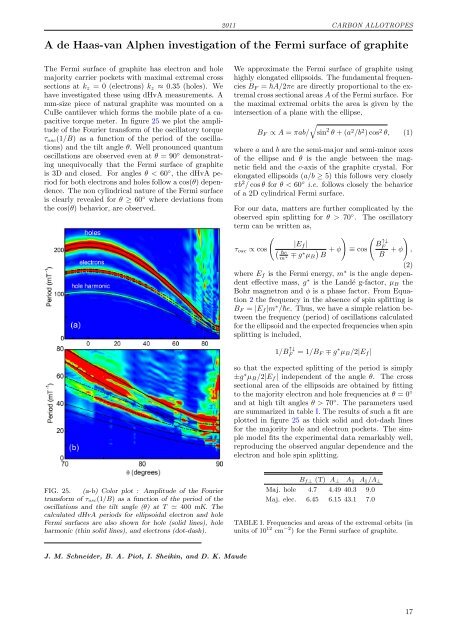2011 - Laboratoire National des Champs Magnétiques Intenses ...
2011 - Laboratoire National des Champs Magnétiques Intenses ...
2011 - Laboratoire National des Champs Magnétiques Intenses ...
Create successful ePaper yourself
Turn your PDF publications into a flip-book with our unique Google optimized e-Paper software.
<strong>2011</strong> CARBON ALLOTROPESA de Haas-van Alphen investigation of the Fermi surface of graphiteThe Fermi surface of graphite has electron and holemajority carrier pockets with maximal extremal crosssections at k z = 0 (electrons) k z ≈ 0.35 (holes). Wehave investigated these using dHvA measurements. Amm-size piece of natural graphite was mounted on aCuBe cantilever which forms the mobile plate of a capacitivetorque meter. In figure 25 we plot the amplitudeof the Fourier transform of the oscillatory torqueτ osc (1/B) as a function of the period of the oscillations)and the tilt angle θ. Well pronounced quantumoscillations are observed even at θ = 90 ◦ demonstratingunequivocally that the Fermi surface of graphiteis 3D and closed. For angles θ < 60 ◦ , the dHvA periodfor both electrons and holes follow a cos(θ) dependence.The non cylindrical nature of the Fermi surfaceis clearly revealed for θ ≥ 60 ◦ where deviations fromthe cos(θ) behavior, are observed.We approximate the Fermi surface of graphite usinghighly elongated ellipsoids. The fundamental frequenciesB F = A/2πe are directly proportional to the extremalcross sectional areas A of the Fermi surface. Forthe maximal extremal orbits the area is given by theintersection of a plane with the ellipse,√B F ∝ A = πab/ sin 2 θ + (a 2 /b 2 ) cos 2 θ, (1)where a and b are the semi-major and semi-minor axesof the ellipse and θ is the angle between the magneticfield and the c-axis of the graphite crystal. Forelongated ellipsoids (a/b ≥ 5) this follows very closelyπb 2 / cos θ for θ < 60 ◦ i.e. follows closely the behaviorof a 2D cylindrical Fermi surface.For our data, matters are further complicated by theobserved spin splitting for θ > 70 ◦ . The oscillatoryterm can be written as,() ( )|E f |B ↑↓τ osc ∝ cos ( e)F+ φ ≡ cosm∓ g ∗ µ ∗ B B B + φ ,(2)where E f is the Fermi energy, m ∗ is the angle dependenteffective mass, g ∗ is the Landé g-factor, µ B theBohr magnetron and φ is a phase factor. From Equation2 the frequency in the absence of spin splitting isB F = |E f |m ∗ /e. Thus, we have a simple relation betweenthe frequency (period) of oscillations calculatedfor the ellipsoid and the expected frequencies when spinsplitting is included,1/B ↑↓F = 1/B F ∓ g ∗ µ B /2|E f |so that the expected splitting of the period is simply±g ∗ µ B /2|E f | independent of the angle θ. The crosssectional area of the ellipsoids are obtained by fittingto the majority electron and hole frequencies at θ = 0 ◦and at high tilt angles θ > 70 ◦ . The parameters usedare summarized in table I. The results of such a fit areplotted in figure 25 as thick solid and dot-dash linesfor the majority hole and electron pockets. The simplemodel fits the experimental data remarkably well,reproducing the observed angular dependence and theelectron and hole spin splitting.FIG. 25. (a-b) Color plot : Amplitude of the Fouriertransform of τ osc(1/B) as a function of the period of theoscillations and the tilt angle (θ) at T ≃ 400 mK. Thecalculated dHvA periods for ellipsoidal electron and holeFermi surfaces are also shown for hole (solid lines), holeharmonic (thin solid lines), and electrons (dot-dash).B f⊥ (T) A ⊥ A ‖ A ‖ /A ⊥Maj. hole 4.7 4.49 40.3 9.0Maj. elec. 6.45 6.15 43.1 7.0TABLE I. Frequencies and areas of the extremal orbits (inunits of 10 12 cm −2 ) for the Fermi surface of graphite.J. M. Schneider, B. A. Piot, I. Sheikin, and D. K. Maude17


